StoryWeaver Spotlight: C.P. Ravikumar
Posted by Remya Padmadas on November 01, 2019C.P. Ravikumar grew up reading translated stories. He translates at least one story or poem on his blog every day to keep the child in him alive. He has translated for National Books Trust and Pratham Books. Navakarnataka Publications has adopted his series of short stories translation in a book called "Kadinalli Beladingalu". His translated poetry collection has been published by Abhinava Prakashana. He has translated several works by famous authors in English and Hindi into Kannada and received appreciation for the same. He toggles between Hindi-Kannada-English, often translating simply for the joy of it.
On StoryWeaver, he has translated many books into Kannada including I Want That One and I Can Help!
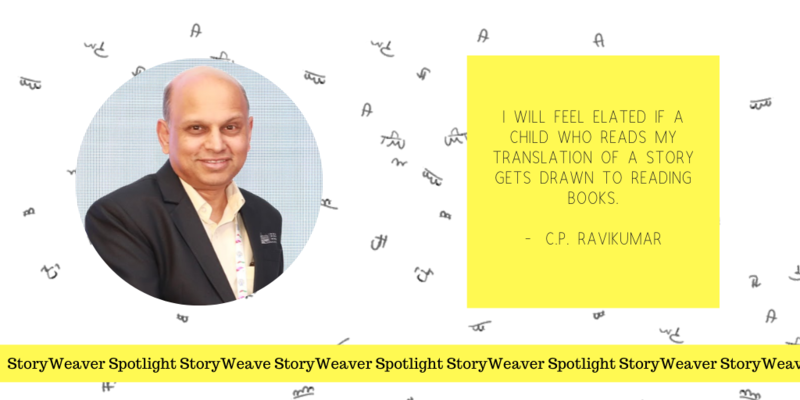
Q: With more than 4 decades of experience in translation, how did you cultivate the skills needed for translating children’s books?
I grew up in a literary environment. My father was a journalist and a writer. He was an avid reader and our house was full of books. I picked up the habit of reading at a young age. When Samudaya, a drama troupe, was looking for someone to translate the Hindi play Bakri (written by Late Sarveshwar Dayal Saxena), my teacher K.N. Nagaraju asked me if I could do it. I had finished my pre-university exam and was awaiting results. I took on the challenge. There were many songs in the play, which is written in the Nautanki style. I adapted Purandara Dasa’s songs in my translation. The songs became a big hit under the music direction of Rajeev Taranath. The play Kuri, directed by M. S. Sathyu, also became a big success.
I got my second break when Navakarnataka Publishers contacted me. They were planning a big project called Vishwa Kathakosha which would have 25 volumes of stories from across the world. The original stories were translated first into English and the manuscripts were handed over to Kannada translators. My father knew the editor of the series Late Niranjana. Niranjana had heard about “Kuri,” and gave me my second big break. I was asked to translate the volume of stories from Vietnam. The volume was called “Kadinalli Beladingalu.” Interestingly, my father also translated a volume of stories from Holland for the series.
When I went to Los Angeles for pursuing my Ph.D., I started translating poetry and stories from Kannada to English. These became instantly popular with the readers of the Usenet group (the precursor of social media in the eighties). I had a large readership and I received a lot of encouragement from many erudite readers. Some Hindi-speaking readers requested me to translate stories and poems from Hindi to English. I have translated hundreds of poems and scores of stories from English to Kannada, Kannada to English, Hindi to Kannada, and Hindi to English. I have collected them in my blogs and they are available online. I have a large number of readers and you will be surprised to know that a big chunk of them are from USA! I enjoy translating. It is an opportunity to get to know a writer and to understand another culture. I also enjoy the challenge of preserving as much of the original flavor in the translation. There is a great sense of satisfaction when translating the classics – poems of Wordsworth, Yeats, and Auden, or sonnets of Shakespeare, Keats and Browning. I have attempted to translate poems from all countries to give Kannada readers a flavor of world poetry. For example, I translated the poems of Xu Lizhi, a young Chinese worker who committed suicide from depression coming from overwork and stress. I have also translated many American poems that have been written for children and adolescents.
Q: You carve out time for translating children’s books from a busy life. What do stories in translation bring to young readers?
It is a pleasure to translate stories for children of all ages. I love spending time with children. My own two children will vouch for my ability to enthrall them with stories. When they were growing up, not a single night went without telling them a story. In the times of globalization, we see that children across the world are exposed to stories from different regions through movies, television and books. In this sense, children today can accept other cultures more easily. There is also an opportunity to pick up some values from other cultures. Take the story of Cinderella, for example. She never weeps, no matter how miserable her life is. She may feel a sense of despair, but she wants to win, nevertheless.
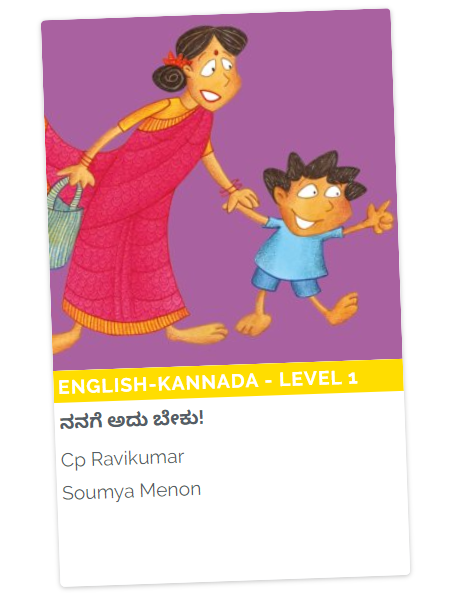
ನನಗೆ ಅದು ಬೇಕು!, translated by C.P. Ravikumar
Q: You are known for translating verses into Kannada, English and Hindi. What is your process while translating these gems? For Eg: Jerry Pinto’s Ming-Ming, Fat Little Bear.
I thoroughly enjoy translating verse. Translating Ming-Ming, Fat Little Bear was a delightful experience. I suppose I ask myself, how I would narrate that story in Kannada to a toddler. In Kannada, like any other language, there are some meters or rhythms that are very popular in children’s verse. It may be best to use one of them in the translation, so that we can build a connection with the child. Sometimes, it may be all right to use our poetic license to do a little bit of adaptation to make the translation seem natural.
Q: We see your fresh translations everyday. What inspires you? We have read your observations on teaching curriculums. According to you, how do stories influence children?
I love to read poems and stories when I am commuting. The commute in the city is long and arduous due to traffic, but it can become interesting if we have internet connectivity and a mobile phone in our hand. Today, there are repositories of literature that one can easily access on the Internet. I am tempted to translate poems or stories that I instantly like when I read them. I share these translations on my blog.
Stories that we grow up with influence our morality and our attitude. I will give you an example. My father used to tell us stories from a well-known book called Neeti Chintamani. There were very simple stories in that book. For example, there is a story of two women, one who was very careful with her resources and another who was careless. Listening to such stories at an early stage can help mold our character.
Q: What is your personal relationship with language and/or translation?
My father was an avid reader and encouraged his children to read. I spent five childhood years in Delhi. When we visited Bangalore once during this period, my father picked up a huge collection of children’s books for us. We had this huge collection of books on our train journey back to Delhi and I and my brother were both hooked. In Delhi, there was a large public library in the vicinity of our house and I spent my summer months reading children’s books in the library. I recall retelling those stories to my classmates. I suppose there is still some of that child in me still.
Q: You have translated / reviewed a handful of stories for us. Which one has been your favourite and why?
I enjoyed translating Ming-Ming, Fat Little Bear. It is a funny little story related in verse form. It is meant for children who are say five or above. That is the age group that is easiest to entertain!
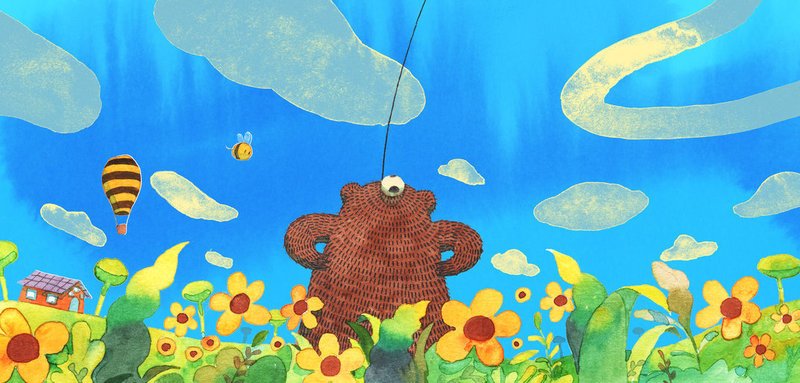
An illustration from the book 'Ming-Ming, Fat Little Bear' translated by C.P. Ravikumar into Kannada.
Q: You have translated stories by well-known authors into Kannada. How do you think a translation can reach a child as opposed to original stories?
To recount my own experience, I read “Robinson Crusoe,” “Oliver Twist,” “Treasure Island” and “Gulliver’s Travels” in Kannada before I read them in English. These Kannada translations were among the books that my father bought us for the train journey. I was enchanted by these stories. I felt the same sense of exhilaration that an English-speaking child may feel when reading the story in English. Reading a story in our native language is easier and more appealing. I hope the best of world-literature becomes available to children through print media as well as digital media.
Q: You have translated a play from Hindi which has successfully been performed with 200 shows. According to you, what form of storytelling is most effective for children - stories told through books, plays or poetry?
Toddlers love stories and rhymes. They love the colorful illustrations in books. Just about anything can happen in these stories! Small children also take naturally to acting a part in a story. As they grow up, children will enjoy stories that will appeal to their sense of logic Teenagers love adventure and fantasy. If the child is lucky, he or she will get exposed to poems from a good teacher and will develop a liking for poetry. Every child should have an opportunity to be part of a school play! Reading a play can be as much fun as reading a story!
Q: What is the experience of translating a children’s book like? Especially as opposed to translating for adults?
Anyone who loves spending time with children, narrating stories to them or reading poems to them, will enjoy translating children’s literature. If you ask me, when I translate a story or poem for children, I imagine narrating that story or poem to a young child. When we translate for children, we have an additional responsibility – we are trying to get a child interested in literature. I will feel elated if a child who reads my translation of a story and gets drawn to reading books.
Q: A book you'd like to recommend to other translators?
I feel many great writers like Roald Dahl have not been translated into Indian languages. What fun it would be to translate Matilda!
Q: You have contributed for us immensely. How has the StoryWeaver journey been? What is one big takeaway from this experience?
The platform you have built is absolutely amazing. It is a pleasure to use the tools and see a book take shape in front of your own eyes!
Q: How do you feel when your story reaches the child?
It is most satisfying to find a like-minded reader. When it comes to a child, I suppose we have the additional challenge of inspiring the child. The illustrations and color go a long way in motivating the child to pick up the book. But if the child can relate to the story or the poem and picks up interest in reading, that would be most gratifying.
Q: How else do you think we can join hands to take more stories to more children in more languages?
You can consider doing reading workshops for children. It is equally important to get the word out about your books to young parents.
Q: You have contributed a piece of an article on the role of a translator for Kannada translation handbook in collaboration with Shabdana, centre for translation under Sahitya Akademi. How relevant do you think are such initiatives?
I am hopeful that such a handbook can be used as the resource material when conducting workshops for budding translators who feel the need to be mentored. Today, we find so much “how to” material online and the younger generation seems to be hooked to them. People are learning how to cook, how to solve math problem or how to troubleshoot their equipment. I suppose there will exist some people who want to know how to translate literature!
Q: What is the hardest thing about translating from English into Kannada/ Hindi to Kannada? How do you navigate words or phrases that are tricky to translate?
English language has borrowed from all other languages and has a very large vocabulary. In English, it is perfectly all right to create new words by combining other words, such as “Bus Stop” or “Hard Disk” or “Read Only Memory.” When we try translating “Bus Stop” literally into Kannada or Hindi, it somehow does not sound right. Either we must shed these inhibitions and create a larger vocabulary or we must look for a word that seems more natural. A long English sentence where predicates are combined with “and” or “or” may seem natural, but appears artificial in a regional language.
Q: Can you tell us anything about yourself and your job that would surprise us:)?
I am a technologist with a background in Electronics and Computer Engineering. I have also published technical papers and books. I have written a technical column called “Janamukhi Tantraloka” for the Kannada daily Vijaya Karnataka.
Do join the conversation by leaving your thoughts in the comments section below. You can also reach out to us through our social media channels: Facebook, Twitter and Instagram.
Be the first to comment.#FreedomtoRead2020: Theresia Alit on creating a digital library of 50 storybooks in Basa Jawa
Posted by Remya Padmadas on March 11, 2020
Theresia Alit is a freelance translator, who translates books from English-Javanese to Bahasa Indonesia-Javanese and vice versa. She is passionate about creating a repository of storybooks in her mother tongue, Basa Jawa, as she feels that the number of people who tell children's stories in Basa Jawa is decreasing. Previously, she has worked on translating stories into Javanese for a project called Serat Kancil. As part of the Freedom To Read 2020 campaign, she has created a digital library of 50 storybooks in Basa Jawa.
In this email interview, Theresia writes about translating books into her mother tongue and the importance of creating children's books in the Basa Jawa.
Do tell us about yourself, your interests, your work.
My name is Theresia Alit, and I am from Indonesia. I am a freelance translator, and I work on translations from English-Javanese to Bahasa Indonesia-Javanese and vice versa. Speaking of interests, I am very interested in traditional culture, languages and people.
We would love to learn about your personal relationship with Basa Jawa - do tell us about it.
I am a native speaker of Basa Jawa, and was raised speaking the language. I find it sad that a lot of people in the younger generation of today do not really speak or understand Basa Jawa, despite it being their mother tongue.
How did you come across StoryWeaver and the Freedom to Read campaign?
I came to know about StoryWeaver and your Freedom to Read campaign on Twitter, from a retweet by the Wikitongues account.
Why do you think is it important to have children’s books in Basa Jawa?
I feel that it is extremely important for the younger generation to learn and read Basa Jawa. In fact, yesterday, I did a campaign with a community of small children, and they were really enthusiastic about reading stories in the language!
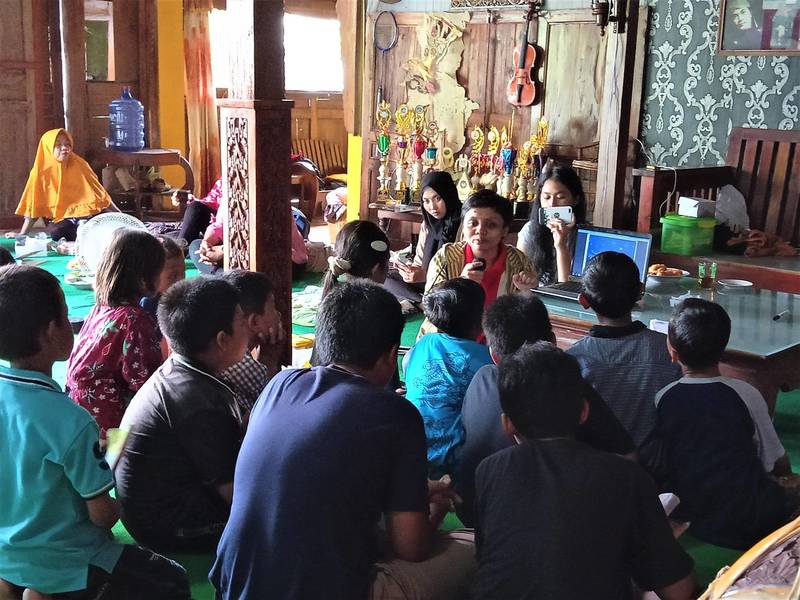
Theresia Alit conducts reading sessions for children in Basa Jawa in Indonesia
Of the 50 storybooks that you translated, which story would be your favourite and why?
I really enjoyed the book, Bayi gajah kang penasaran. It's so funny!

What are some of your favourite books from childhood? Is there any memorable reading moment that you would like to share?
Some of my favourite books are The Little Prince, Asterix and Obelix, Uthak-uthak Ugel (folktale), etc. When I read a book, I feel that I am moving into another world altogether. (just like Puchku!)
You can read all of Theresia Alit's translated storybooks here.
Do join the conversation by leaving your thoughts in the comments section below. You can also reach out to us through our social media channels: Facebook, Twitter and Instagram.
comment (1)'My favourite thing to draw is portraits of people I meet when I travel' - Illustrator Anjora Noronha on creating art
Posted by Yamini Vijayan on October 31, 2017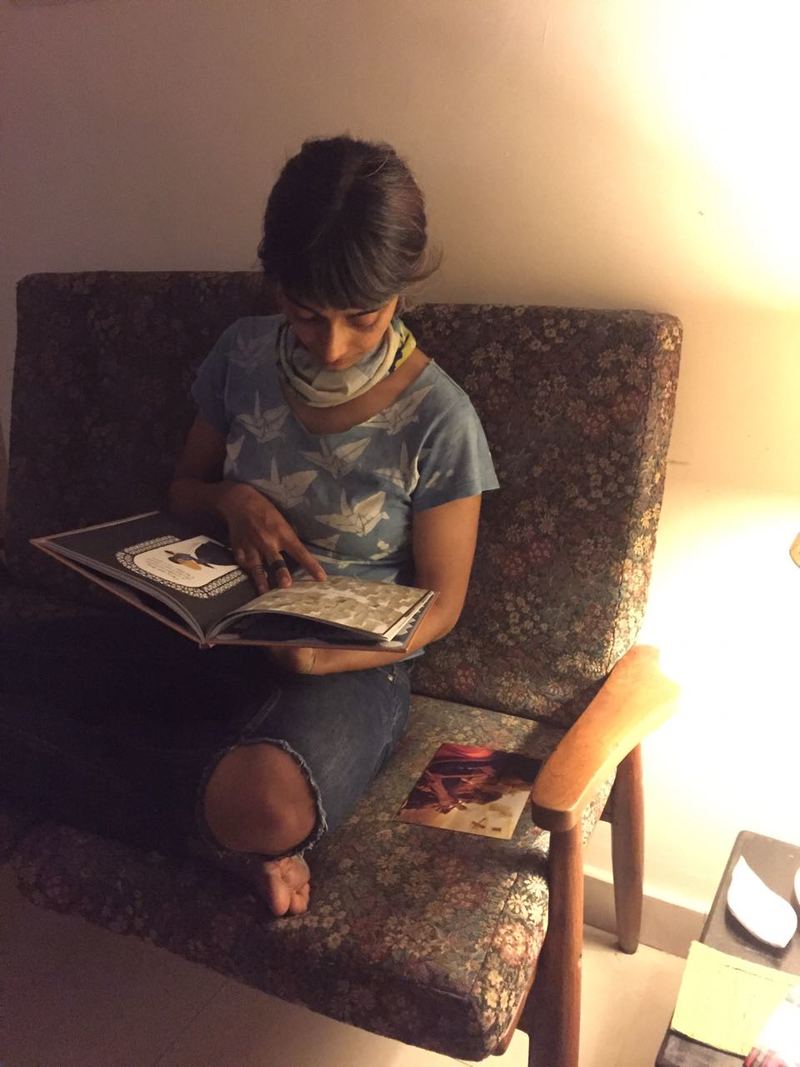
Anjora Noronha was one of the Illustrator Gurus for our #6FrameStoryChallenge in 2015, and we're delighted that she is illustrating a book for Pratham Books this year. Written by Sheila Dhir, this story is about the moving friendship between a goby fish and a pistol shrimp who live deep in the ocean.
Read a short interview with Anjora, in which she gives us a peek into into her illustration process.
What mediums do you most enjoy working with? How do you choose a particular medium for a story?
For personal projects, my drawing kit contains a sketchbook, watercolour postcards, a tiny bottle of Indian ink, a tiny tube of watercolour in ivory black, a mechanical pencil, a 'pencil' eraser, an aquapen, a MUJI gel pen (LOVE) and lots of tissues collected from all over the place.
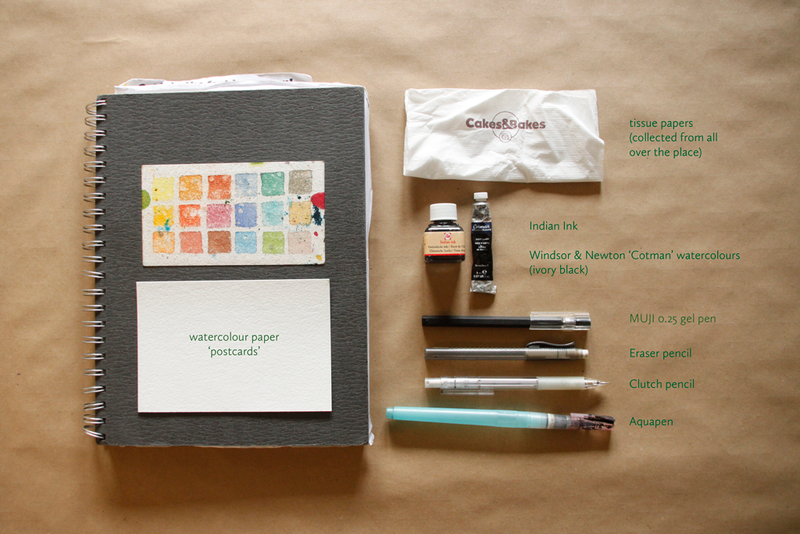
Other than that, I don't have a particular style or medium that I work with, so the start of a new project is always a mix of excitement and nervousness at discovering which medium is going to be the medium of choice. I somehow never know, and so each time I start, I have to go through sheets and sheets of paper and material, looking for what 'feels right'. 'What feels right' includes: how much texture I can achieve; if the essence of the medium suits the essence of the story (this is naturally highly subjective); and also very simply - if it excites me.
What kind of stories do you enjoy working on the most?
For children's books I prefer working on books that have a strong environmental theme. For adults I prefer working on stories about people and cultures. My favourite thing to draw is portraits of people I meet when I travel.
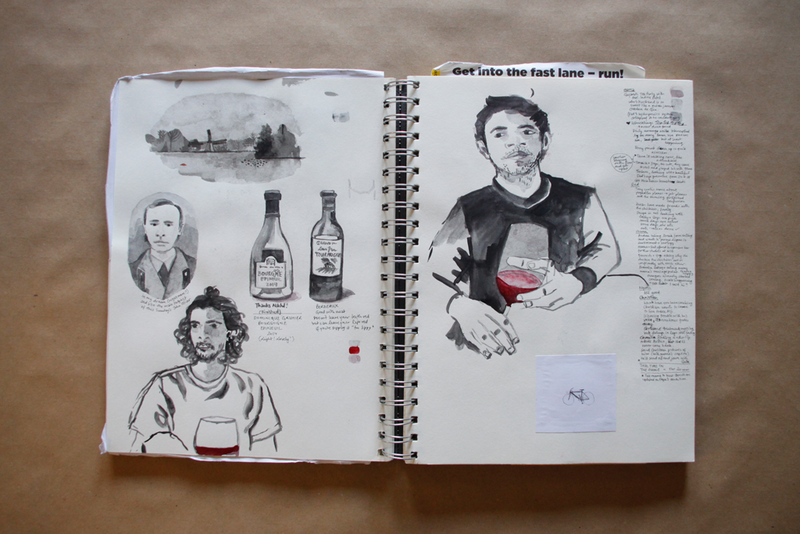
Which part of your work do you enjoy the most, and which part do you enjoy the least?
The most enjoyable part is when all the frames and page sketches have been approved and finalized, and it's time to colour them in. That is the most charming part of any project for me: I put on music, or a podcast, and spend hours glued to my desk in creative solitude. Most details have been decided by this stage, at this point it is a matter of turning off the thinking side of my brain and allowing things to happen on their own. I sleep at night excited about the next day of drawing. Even though I find it more challenging, I also love the character development stage because either I act out expressions and postures, or I ask someone to act them out for me. What I enjoy the least is scanning and cleaning the final artworks and preparing them for print. Following that, there's always the big existential angst about which font to chose, and at what size, with very few helpful cues from the universe.
This year, you’re illustrating a book for us on the symbiotic relationship between a goby fish and a pistol shrimp. We loved all the character sketches you made for this. What kind of preparation goes into illustrating a book for children?
Ideally, the initial stage would involve doing studies of the characters from life, but since I didn't have access to the two main characters in the story I'm currently working on, I watched as many YouTube videos and read as many articles as I could. Then I filled many pages with drawing after drawing of the characters, repeating them over and over again. My aim was to get to know these two so that I could intuitively draw them in any situation. This was followed by a style and colour test, which is the phase where I try to discover which medium I will be working in. For this book, it is colour pencil, which is a medium I have never worked in before. I tweaked my colour palette multiple times and drew one page over and over again, changing individual details with every attempt to discover what textures and effects I could achieve with them. I have stopped using sites like Pinterest to find inspiration.
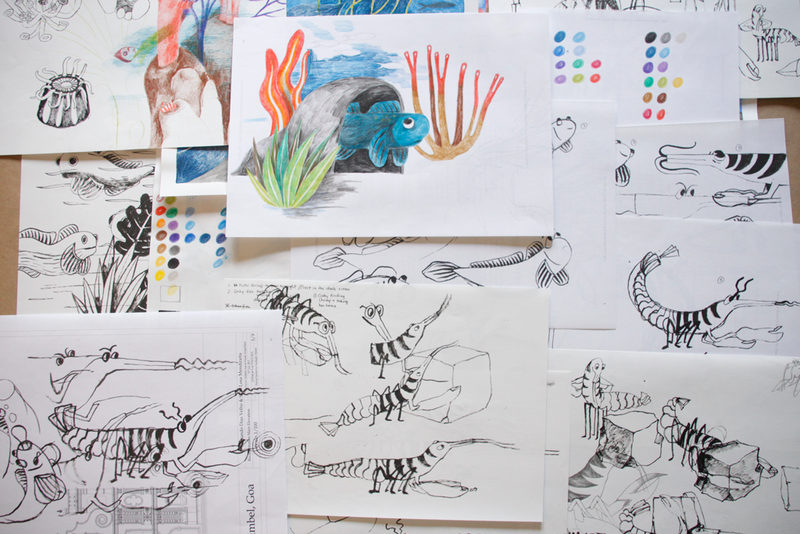
The third phase has been to thumbnail the entire book, and incorporate feedback. The practical side of illustrating for children cannot be ignored, and I like collaborating with editors as they are involved in the entire process but are not stubborn and attached to everything (as illustrators tend to get). This is where we have reached so far. Some pages need to be tweaked, some are good to spend afternoons of coffee and music with. Each thumbnail will be fully detailed and shared with the editors before being coloured in. The last stage is scanning, cleaning and layout. After that I hand over the files and wait for the printed books to come by mail :)
Who are some of the illustrators whose work you follow closely?
For children's books: Carson Ellis and Júlia Sardå Portabella. http://www.carsonellis.comhttp://www.carsonellis.com has a Q&A section on her website, and one of the things she speaks about is her limited gouache colour palette, and how - when she added a colour to it - it was quite ground-breaking for her. Júlia Sardå Portabella seems to work mostly digitally, so I turn to her work for clues on how to work digitally - a new medium for me. Recently I discovered the work of Joann Sfar, and have bought every book of his that I can get my hands on. The colourful and surprising artwork of Brecht Evens. One of my favourite young, contemporary artists is this guy called Ward Zwart, who puts up a lot of his work online, but is very mysterious otherwise. (He did reply directly to a message I left him on Instagram though :) Stephanie K. Birdsong, mostly known as shoulda-woulda-coulda: for her daily and very quirky warm up paintings in her Planner. Oh, to be so productive on a daily basis! And of course, the work of my peers in India, some of whom I know personally, and whose creative journeys I have been following for a while now.
How do you deal with creative blocks?
In three ways. The first is that I break down what I have to do into micro steps, and then push myself to complete one micro-task after the other, all the while telling myself that I can change everything at a later stage. The point is just to gain momentum, which always leads to enthusiasm. Most of the time, producing a lot of work that doesn't work leads to something that does work, and when that moment comes, the Battle against the Block is won. The more involved I get with an artwork, the more enthusiastic I am to delve into the details and spend time on it. The second is that I try to meet someone who is currently in a good creative place / moment. There is nothing that kindles my excitement about the work that we illustrators and designers do, than having a long, dense conversation about the nitty-gritties of the creative process. There hasn't been a time when it hasn't left me fired up to sit down at my own table and MAKE. The third is to not allow myself a break after completing a big project, so that I don't lose the rhythm and flow, but I'm still working on that, I almost always end up taking a short break :P
Anjora Noronha grew up in Vienna, moved back home to Goa, studied at the Srishti School of Art and Design in Bangalore, worked in Delhi, and then studied more at the University of Barcelona. She currently lives between the Indian tropics and a windy little town somewhere in northern Europe, where she works as an illustrator on a variety of projects ranging from comics, children’s books, and historical books of places long forgotten.
comment (1)